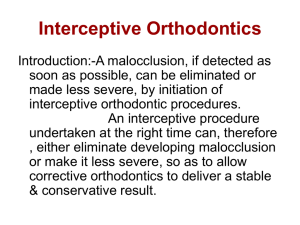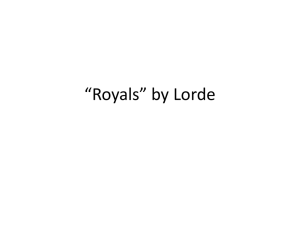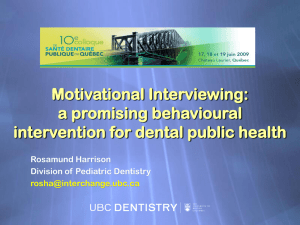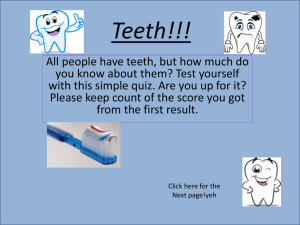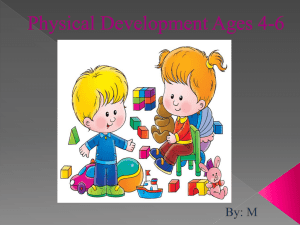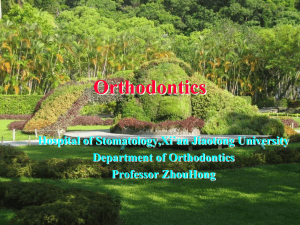PREVENTIVE ORTHODONTICS
advertisement
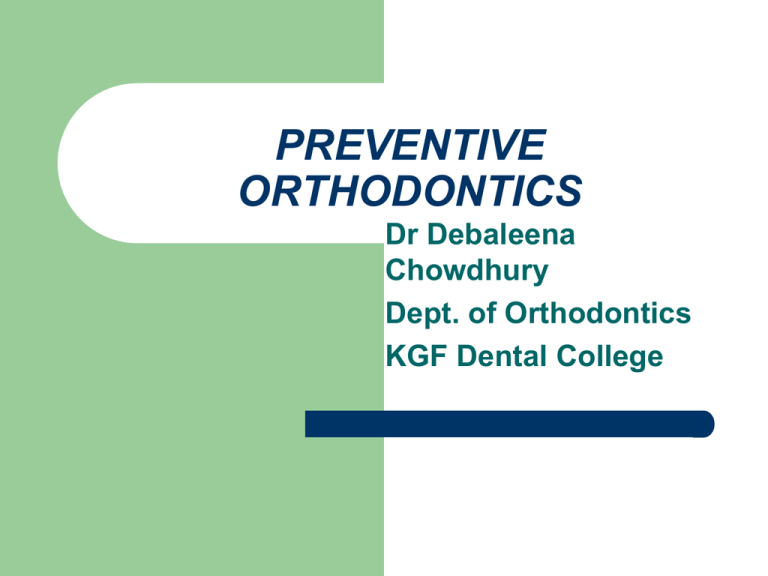
PREVENTIVE ORTHODONTICS Dr Debaleena Chowdhury Dept. of Orthodontics KGF Dental College PREVENTIVE ORTHODONTICS Definitons “Action taken to preserve the integerity of what appears to be a normal occlusion at a specific time.” - Graber (1966) “Prevention of potential interferences with occlusal development.” - Proffit & Ackerman . Preventive measures Parent counselling Caries control Space maintanence Management of abnormal frenal attachments Preventive measures (contd.) Treatment of locked permanent first molars Abnormal oral musculature & management of related habits Extraction of supernumerary teeth Parental education A. Prenatal counselling Education of the expecting mother B. Postnatal counselling Associated with the clinical examination of the child at a. 6months - 1 year c. 3 years b. 2 years d. 5- 6 years Caries control Caries of decidious teeth can cause malocclusion a. Nursing bottle caries b. Rampant caries Nursing bottle caries Rampant caries Proximal caries causes loss of arch length Treatment -Diet counselling -Pulpectomy & pulpotomy -Topical flouride application -Stainless steel crown Stainless steel crown Space maintenance Indicated in early loss of decidious teeth Two types of space maintenance Removable Functional ( teeth incorporated ) Non functional Fixed -Band & loop -Nance holding arch -Crown & loop -Lingual arch -Distal shoe Band and loop Crown and loop Distal shoe Nance holding arch Lingual holding arch Treatment of locked permanent first molars Prominent distal bulge of second decidious molar prevents proper eruption of first permanent molars. Treatment - Proximal stripping Management of abnormal frenal attachments Gingival frenal attachments lead to malocclusion ,e.g. midline diastema Ankyloglossia Surgical treatment Ankyloglossia INTERCEPTIVE ORTHODONTICS Dept. of Orthodontics Yenepoya Dental College INTERCEPTIVE ORTHODONTICS Interceptive orthodontics has been defined as that phase of the science and art of orthodontics employed to recognize and eliminate potential irregularities and malpositions of the developing dentofacial complex Interceptive Procedures Serial extraction Correction of developing cross bite Control of abnormal habits Space regaining Muscle exercises Interception of skeletal malrelation Removal of soft tissue or bony barrier to enable eruption of teeth Serial extraction Procedure that indicates the planned extraction of certain decidious teeth and later specific permanent teeth in an orderly sequence and predetermined pattern to guide the erupting permanent teeth into a more favorable position Rationale for serial extraction Arch length tooth -material discrepancy Physiologic tooth movement : By selective removal of some teeth the rest of the teeth which are in the process of eruption are guided by the natural forces into extraction spaces Serial extraction :Indications Class 1 malocclusion showing harmony between skeletal and muscular system Arch length deficiency ; features: Absence of physiologic spacing Malpositioned or impacted laterals Crowded upper and lower anteriors Abnormal eruption pattern Ankylosis of one or more teeth Serial extraction indications (contd.) where growth is not enough to overcome the discrepancy Patients profile with pleasing and straight Serial extraction - Contraindications Class II & III malocclusions with skeletal abnormalities spaced dentition Oligodontia Open bite & deep bite Midline diastema Mild discrepancy between arch length and tooth material Methods of serial extraction Dewel’s Tweed’s Nance method method method Dewel’s method CD4 Tweed’s & Nance method DC4 Nance method DEVELOPING ANTERIOR CROSSBITE Condition characterised by reverse overjet wherein one or more maxillary anterior teeth are in lingual relation to the mandibular teeth. Early interception is necessary. ANTERIOR CROSS BITE Reasons for early treatment: crossbite in deciduous dentition may progress to permanent dentition. simple problem may progress towards more complex skeletal problems. CLASSIFICATION OF ANTERIOR CROSSBITE DENTOALVEOLAR Rx – tongue blade, Catalan’s appliance, double cantilever spring with P.B.P. SKELETAL Best treated during growth by growth modification procedures FUNCTIONAL (pseudo-crossbites) Rx - removal of occlusal interferences. INTERCEPTION OF HABITS Thumb sucking Rx bitter solvents thumb cap palatal crib Tongue thrust Rx palatal crib tongue exercises Mouth breathing Rx oral screen surgical removal of nasal obstructions SPACE REGAINING Space gained by distalization of first molar which have been moved mesially due to early loss of deciduous molars. Gerber space regainer Space regainer using jack screws Space regainer using cantilever spring MUSCLE EXERCISES Exercises for masseter muscle clenching of teeth by patient while counting to 10. Exercises for lips (circumoral muscles) Holding and pumping of water back and forth behind the lips. Massaging of the lips Button pull exercises Tug of war exercises Exercises for tongue One elastic swallow Tongue holding exercises Two elastic swallow Hold-pull exercise INTERCEPTION OF SKELETAL MALRELATION Interception of Class II malrelation Face bow with headgear Myofunctional appliances • Interception of Class III Chincup with headgear FR III Facemask therapy REMOVAL OF SOFT AND HARD TISSUE BARRIERS Surgical excision of soft tissue and any overlying bone above the crown of unerupted tooth



